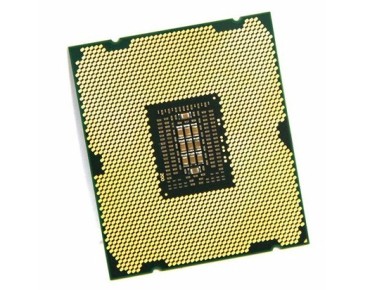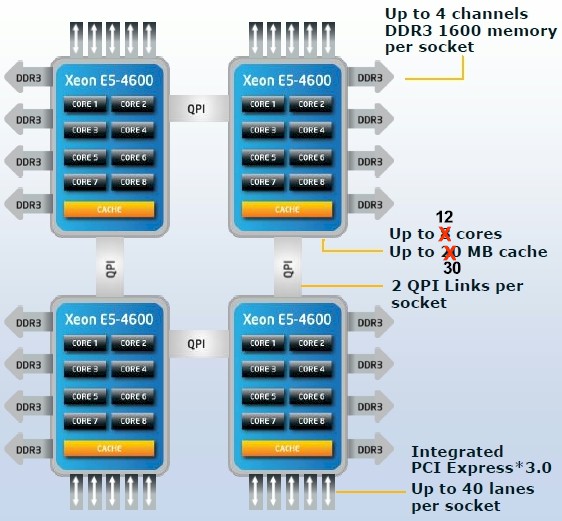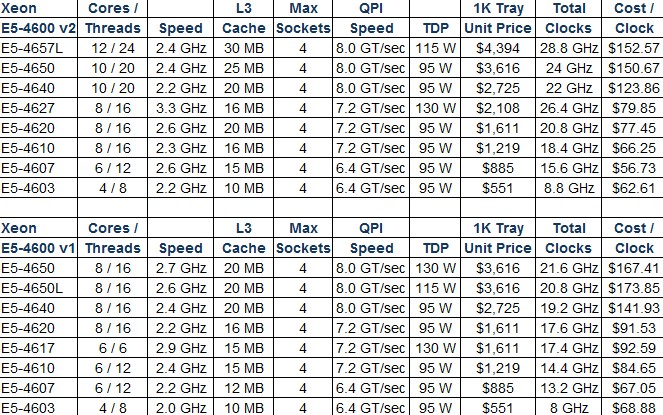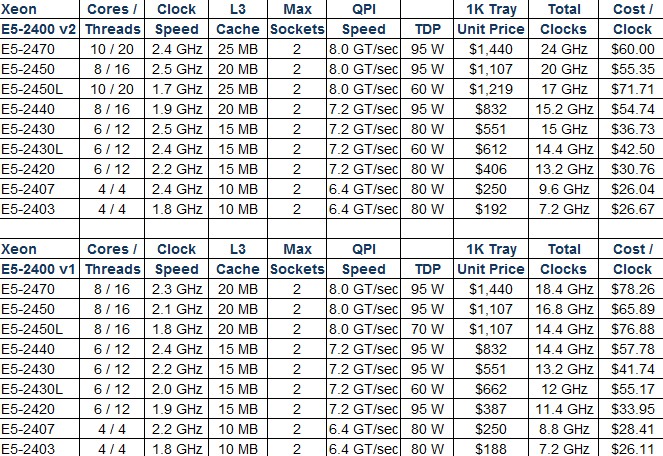Intel Quietly Revamps Remaining Xeon E5 Lineup

The Xeon E5 is not one single line of processors, but rather four distinct variations on a theme aimed at difference price, performance, and scalability needs. Two weeks ago, Intel made a big hullaballoo about the Xeon E7 v2 chips, which offer the highest core counts, memory capacity, and NUMA scalability of all of its chips. Now, Intel is quietly releasing the E5-4600 v2, which overlaps the Xeon E7 v2 processors a bit.
As it turns out, Intel has already slipped out updates to the low-end of the Xeon E5 line, the E5-2400 and E5-1600. (You can see these chips in the latest Intel processor price list.)
All of these "Ivy Bridge" Xeon E5 v2 chips plug into existing Xeon E5 v1 "Sandy Bridge" platforms, so there is not much in the way of new engineering that needs to get done. This might be why Intel is not making much of a fuss. Moreover, Intel wanted most of the attention to be on the Xeon E7 v2 processors it looks like. The company is also preparing to launch the "Haswell" variants of the Xeon E5s later this year, and these will come with a whole new platform and will therefore need much more of a marketing push.
The E5-4600 processors coming out this week are aimed at density-optimized four-socket servers, machines that can cram four sockets into 2U of rack capacity instead of the 4U or 5U or more that a Xeon E7 machine requires because of its external memory buffer cards. The E5-4600s are also aimed at full-width, single height blade servers that are thinner than the Xeon E7 alternatives. The high memory bandwidth and capacity and the extra cores of the Xeon E7 come at the cost of burning more energy and dissipating more heat. For some workloads, a Xeon E7 is either too expensive or is overkill for the job. This why Intel took a Xeon E5-2600 aimed at a two-socket machine and tweaked it so it could extend out to four sockets in a single system image.
The Xeon E5-2600 chip, whether you are talking about the first generation launched in March 2012 or the second generation that came out in September 2013, is the workhorse processor, with dual QuickPath Interconnect (QPI) links lashing together the two processor sockets gluelessly so they can share a single memory space and run a single operating system that can span all of its cores and threads. The dual QPI links give it very efficient performance on NUMA clustering and tightly binds the memory and I/O hanging off both processor sockets to both of those sockets. The Xeon E5-2600 machines are chosen by most large enterprises for most of their distributed computing needs.
With the E5-4600 processors, Intel takes the two QPI links coming off each processor socket and uses them to link four processors into a ring, like this:
The new Xeon E5-4600s are based on Intel's latest Tri-Gate 22 nanometer process technology, which allows for substantially smaller circuits to be etched on a silicon wafer than with the 32 nanometer technology that was used with the prior E5-4600 generation. Sources at Intel tell EnterpriseTech that, on average, the new E5-4600 v2 processors will deliver about 40 percent more performance than their predecessors.
Here is how the new E5-4600 v2 chips compare to the prior v1 generation:
To give a rough gauge of relative price/performance, we have multiplied the core counts by the clock speed to come up with an aggregate performance, expressed in total gigahertz, for each chip. Obviously, there are substantial performance differences between the Sandy Bridge and Ivy Bridge cores, so that relative performance comparison has its limits. Obviously, the best thing to do is look at a wide variety of benchmarks that relate to your current and possible future workloads and make more educated comparisons, and of course the best thing to do is run benchmarks of your actual applications on a variety of hardware to see how different mixes of cores, cache, QPI links (speed as well as number), and other features change the performance of those applications. The pricing above is not street price, but rather the list price that Intel charges for 1,000-unit trays of processors to its server OEM customers and other resellers. Street prices for processors are set by the OEMs and distributors of these chips.
Intel says that sixteen of its server partners have 21 different configurations of machines that are available to run the Xeon E5-4600 v2 chip in their "Romley-EP 4S" platforms. The Romley platform includes the "Patsburg" C600 chipset and the LGA2011 socket that is also used by the E5-2600 for two-socket machines and by the E5-1600 chips for single-socket boxes. The Ivy Bridge cores have updated vector math units and better Turbo Boost clock acceleration as well as other microarchitecture improvements that squeeze more integer and floating point work out of each clock cycle compared to Sandy Bridge parts.
The Update on the Low End
Just like the E5-4600 v2 is kind of a poor man's E7-4800 v2 in the four-socket realm, the E5-2400 v2 is a budget version of the E5-2600 v2 in the two-socket arena. (Intel did mention these chips in a blog post on January 9, but did no outreach beyond this.)
The Xeon E5-2400 is specifically a version of the E5-2600 with only one QPI link between the two sockets in the machine, instead of two; the E5-2400s have slightly lower clock speeds and therefore slightly lower prices. The E5-2400s are aimed at supercomputer clusters where price/performance and performance per watt per dollar are the most important factors in a CPU and system buying decision.
Here is the v1 and v2 lineup for the E5-2400 processors:
The v2 version of the E5-2400 chips plug into the same LGA1356 socket as their "Sandy Bridge" v1 predecessors. They top out at ten cores, and come in variants with slightly higher clock speeds in the same 60 watt, 80 watt, and 95 watt thermal bands. Generally speaking, if the core counts and price is the same between v1 and v2 generations, then the clock speeds and sometimes the L3 cache is higher. Intel is using the shrink from 32 nanometers to 22 nanometers to boost the clock speeds. It is not clear what the company has planned for the Haswell generations of E5 processors, but increasing clock speeds is tough because energy use and heat dissipation increase at an exponential rate with clock speed. Getting to 4 GHz is painful, which is why Intel has not done it except in very special circumstances and certainly not as a standard, volume product.
Further down the Xeon server lineup is the E5-1600, which is aimed at single socket workstations and servers where heat is not an issue and high clock speed is more important than the number of cores or the size of the L3 cache. Here is a chart comparing the v1 and V2 version of the E5-1600:
There is not much difference between the old and new chips, as you can see, aside from the adoption of the new Ivy Bridge cores. The E5-1600 v2 processors have the same core counts, L3 cache sizes, and prices as their predecessors, but push the clock speeds up by between 100 MHz and 400 MHz, depending on the model. These plug into the LGA2011-0 socket. The Xeon E5-1600 is functionally equivalent to an "Ivy Bridge" E3-1200 v2 or "Haswell" Xeon E3-1200 v3, both of which are already on the market. The big difference is that the E3-1200 chips top out at four cores per die and only support four memory sticks on their single socket, while the E5-1600 comes in versions with four or six cores and supports more main memory.
All eyes now turn to the Haswell Xeon E5 and E7 processors in the future. The Haswell Xeon E5-2600s will come out first, and as EnterpriseTech previously reported, are slated for delivery towards the end of this year with their new "Grantley" platform and "Wellsburg" chipset. Our best guess is that Intel wants to announce the Haswell Xeon E5 chips at Intel Developer Forum this coming September, particularly if the "Broadwell" editions of chips for desktops, laptops, and microservers slip as has been rumored. This slip may have more to do with economics and market conditions than with the 14 nanometer manufacturing process that the Broadwell chips will employ.
What we know is that for the past several launches, Intel has been keen to get its workhorse Xeon E5-2600 processors lined up with Ethernet and InfiniBand networking transitions. Mellanox Technologies is working hard to get its first 100 Gb/sec Ethernet and InfiniBand switches and adapters out the door in either late 2014 or early 2015. Early adopter customers at the national labs could be getting machines that marry 100 Gb/sec networking and the Haswell Xeon E5s towards the end of the year, and if need be, the general launch can be pushed to early 2015. This is precisely what happened with the Sandy Bridge Xeon E5 chips, although 56 Gb/sec InfiniBand and Ethernet from Mellanox was ready to go the prior fall and so were the server makers.
A lot of moving parts need to come together to make a system and a cluster platform, and that is what makes this IT racket a challenging business and an exciting one.














